
Kitten Milk Replacer (KMR) is a nutritionally balanced formula designed to replace a mother cat’s milk for kittens. It is essential for orphaned or motherless kittens, ensuring proper growth and development. KMR provides vital nutrients, vitamins, and minerals that kittens need to thrive. Proper feeding with KMR is critical to prevent health issues and promote overall well-being. This guide will walk you through the ins and outs of using KMR effectively for your kitten.
What is KMR?
Kitten Milk Replacer (KMR) is a specially formulated nutritional supplement designed to mimic the composition of a mother cat’s milk. It is primarily used for orphaned kittens, those rejected by their mother, or kittens whose mother is unable to produce milk. KMR provides essential nutrients, including proteins, fats, vitamins, and minerals, that are crucial for a kitten’s growth and development. Unlike regular cow’s milk, KMR is easily digestible by kittens and does not cause harmful side effects like diarrhea or dehydration. It is available in powdered or liquid forms and is widely recommended by veterinarians and animal care specialists. KMR is an ideal solution for hand-raising kittens, ensuring they receive the nourishment they need to thrive during the critical early weeks of life. Proper preparation and feeding of KMR are vital to maintain a kitten’s health and prevent complications. Always use a reputable brand and follow the instructions carefully to ensure the best outcomes for your kitten.
Why KMR is Essential for Kittens
KMR is a nutritional lifeline for kittens, especially those without access to their mother’s milk. It provides essential nutrients like proteins, fats, vitamins, and minerals that are vital for growth and development. KMR is formulated to mimic the natural composition of a mother cat’s milk, making it easily digestible and reducing the risk of digestive issues. Without KMR, kittens may suffer from malnutrition, dehydration, or other health complications, which can be life-threatening. Regular cow’s milk is unsuitable for kittens due to its inability to provide the necessary nutrients and its potential to cause diarrhea. KMR ensures that kittens receive the balanced nutrition they need to thrive during their critical early weeks of life. Veterinarians widely recommend KMR as the best alternative to a mother’s milk, making it an indispensable resource for raising healthy, strong kittens.
When to Use KMR for Kittens
KMR is essential for kittens in specific situations where their mother’s milk is unavailable or insufficient. Newborn kittens (0-1 week old) require KMR every 2 hours to ensure proper hydration and nutrition. As they grow, feeding frequency decreases, but KMR remains vital until they are about 8 weeks old. Use KMR if the mother cat is absent, ill, or not producing enough milk. It is also necessary for orphaned kittens or those rejected by their mother. KMR should be used for kittens with health issues or those failing to gain weight. Always follow the manufacturer’s instructions for mixing and feeding to avoid digestive problems. KMR is a lifesaver in these critical early weeks, ensuring kittens receive the nutrients they need to thrive. Proper timing and consistency in feeding are key to their healthy development.
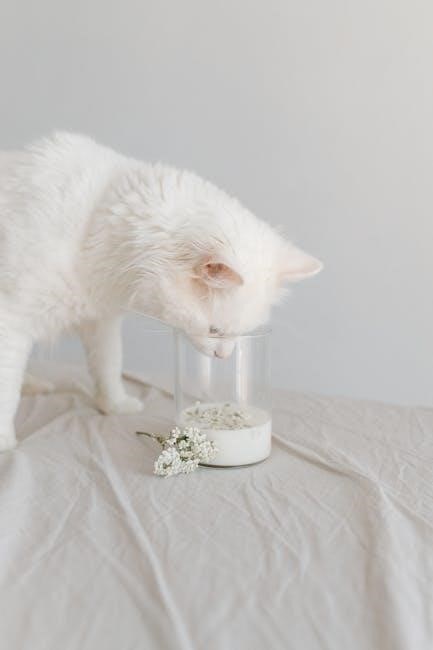
Importance of Proper Feeding for Kittens
Proper feeding is crucial for kittens to prevent digestive issues like diarrhea and ensure they absorb essential nutrients. It supports healthy growth, strengthens immunity, and avoids life-threatening health risks associated with malnutrition or improper feeding methods.
Risks of Improper Feeding
Improper feeding can lead to severe health issues in kittens, including dehydration, electrolyte imbalances, and hypoglycemia. Feeding cow’s milk or incorrect formulas can cause diarrhea, which can be fatal in young kittens. Overfeeding or underfeeding may result in malnutrition, stunted growth, or organ failure. Incorrect preparation of KMR, such as using too much or too little powder, can disrupt nutrient balance. Feeding at the wrong temperature or frequency can also lead to digestive problems. Additionally, improper feeding techniques, like bottle feeding incorrectly, can cause aspiration or choking. Neglecting proper hygiene during feeding can introduce harmful bacteria, leading to infections. It is crucial to follow precise guidelines to ensure kittens receive the nutrition they need for healthy development. Failure to do so can result in lifelong health complications or even death. Proper feeding practices are essential to safeguard a kitten’s well-being and promote optimal growth.
Benefits of Using KMR
Kitten Milk Replacer (KMR) is a nutritionally balanced formula specifically designed to meet the dietary needs of kittens. It provides essential vitamins, minerals, and proteins that are crucial for healthy growth and development. Unlike cow’s milk, KMR is easily digestible and reduces the risk of diarrhea and dehydration, which can be life-threatening for young kittens. Proper use of KMR ensures that kittens receive adequate nutrition, even in the absence of their mother’s milk. It supports strong immune system development and helps prevent malnutrition. KMR also promotes healthy weight gain and energy levels, which are vital for kittens during their rapid growth phase. Additionally, it is convenient to prepare and widely available at pet supply stores, making it a reliable option for caregivers. By using KMR, you can provide your kitten with the best possible start in life, ensuring optimal health and development.
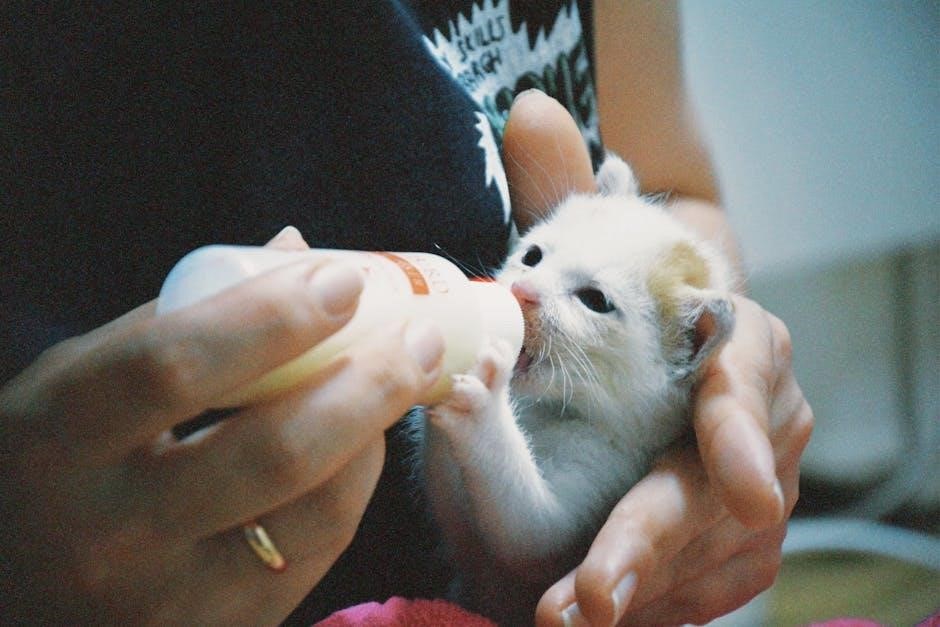
Preparing KMR Kitten Milk Replacer
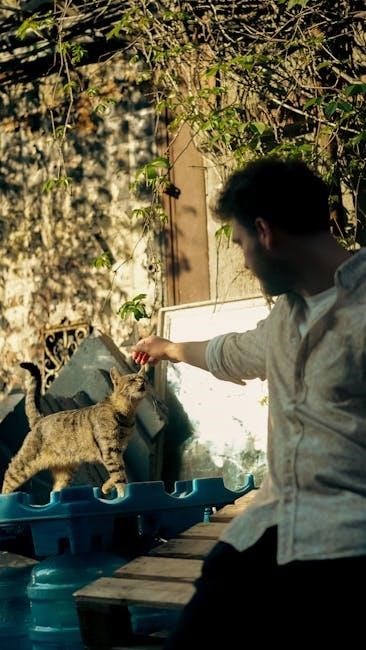
Materials Needed for Preparation
To prepare KMR, you’ll need KMR powder, a clean bowl, a scoop, warm water, a bottle with a nipple, and a thermometer to ensure the milk isn’t too hot. Cleanliness is crucial to prevent contamination and ensure the kitten’s safety.
To prepare KMR kitten milk replacer, you will need a few essential materials to ensure safety and proper mixing. Start with a high-quality KMR powder specifically designed for kittens. You will also need a clean, sterilized bowl or container for mixing. A measuring scoop or spoon is necessary to accurately measure the powder. Warm water is required to mix with the powder, and it’s important to use bottled or filtered water to avoid contaminants. A clean glass or plastic bottle with a tight-fitting lid is needed for storage. A baby bottle with a nipple designed for kittens is essential for feeding. Additionally, a thermometer can be useful to check the temperature of the mixed formula, ensuring it’s not too hot for the kitten. Optional items include a feeding syringe for smaller or weak kittens. Always ensure all utensils and bottles are sterilized before use to prevent bacterial growth and keep your kitten safe. Proper preparation is key to providing a healthy start for your kitten.
Step-by-Step Mixing Instructions
Mixing KMR kitten milk replacer requires precision to ensure the formula is safe and nutritious for your kitten. Start by boiling water and letting it cool slightly to avoid overheating the mixture. Measure one part of KMR powder using the provided scoop or a clean, dry spoon. Gradually add this to two parts of warm water in a sterilized bowl. Whisk the mixture thoroughly until the powder is fully dissolved, ensuring there are no lumps. Allow the mixture to cool to room temperature to prevent burning the kitten’s mouth or throat. Once cooled, pour the prepared KMR into a clean, sterilized bottle. Secure the nipple tightly and test the flow by gently squeezing the bottle. If the flow is too slow, you can slightly enlarge the nipple hole with a sterile needle. Always discard any leftover formula after 24 hours to prevent spoilage. Proper mixing ensures the kitten receives the nutrients needed for healthy growth and development.
Storage Tips for Prepared KMR
Proper storage of prepared KMR is crucial to maintain its quality and safety for your kitten. Always store leftover KMR in a clean, airtight container, such as a glass bottle, and refrigerate it immediately. Use prepared KMR within 24 hours to prevent spoilage and bacterial growth. Before refrigerating, ensure the formula has cooled to room temperature to avoid condensation, which can lead to mold. Never freeze KMR, as it can separate and lose its nutritional value. When refrigerated, KMR may thicken slightly; gently stir or shake the bottle before use to restore its consistency. Always check the formula for any signs of spoilage, such as an off smell or mold, before feeding your kitten. If in doubt, discard the mixture and prepare fresh. Proper storage ensures the formula remains safe and nutritious for your kitten’s needs.
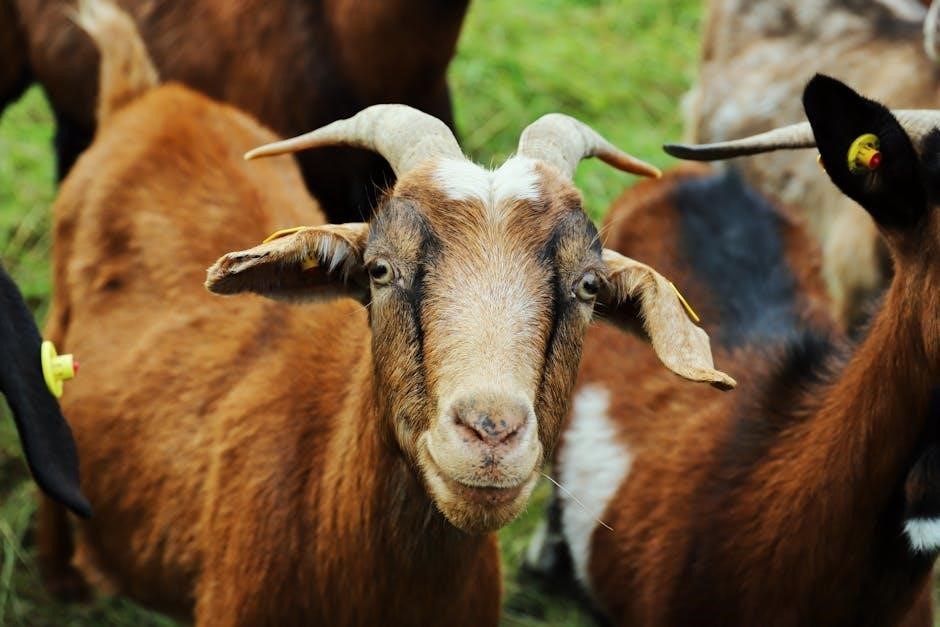
Feeding Techniques for Kittens
Effective feeding techniques ensure kittens receive proper nutrition. Bottle feeding, syringe feeding, and burping are essential methods. Always handle kittens gently, maintain proper positioning, and use clean utensils to prevent infections and promote healthy feeding habits.
Bottle Feeding Instructions
Bottle feeding is a common method for feeding kittens using KMR. Start by gently opening the kitten’s mouth with your finger and slipping the nipple in. Once the kitten latches on, hold the bottle at an angle to prevent air bubbles. Feed in a quiet, warm space to reduce stress. For newborns, feed every 2-3 hours, offering 1-2 ml per feeding. As kittens grow, gradually increase the amount and extend the feeding intervals. Always use a clean, sterilized bottle and nipple to avoid infections. If the kitten struggles to latch, try gently expressing a drop of KMR onto their tongue to stimulate sucking. Never force-feed, as this can lead to aspiration. Burp the kitten after each feeding to relieve gas. Monitor their weight and adjust feeding volumes accordingly. Consult a vet if issues arise.
Syringe Feeding Method
Syringe feeding is an alternative method for feeding kittens when they are unable to nurse or require assistance. Begin by preparing the KMR mixture as instructed and drawing it into a clean, sterile syringe. Gently open the kitten’s mouth with your finger and place the syringe at the corner of their mouth. Slowly depress the plunger, allowing the kitten to swallow at their own pace. Ensure the syringe is held horizontally to prevent liquid from entering the lungs. For newborns, administer 1-2 ml per feeding, gradually increasing as the kitten grows. Feed every 2-3 hours, or as needed based on the kitten’s weight and age. Always monitor the kitten’s response and adjust the flow rate to avoid choking. If the kitten shows signs of distress or refuses to swallow, stop immediately and consult a veterinarian. Syringe feeding requires patience and careful attention to ensure the kitten receives proper nutrition without aspiration risks.
How to Burp a Kitten
Burping a kitten is a crucial step after feeding to ensure they digest their food properly and avoid discomfort. Start by sitting the kitten upright on your lap or in your hands, supporting their chest and head. Gently pat the kitten’s back with an open hand, using a firm but gentle motion, to help release any trapped air. You may need to rub their back in circular motions or apply light pressure to encourage a burp. If the kitten is fussy or squirms, try calming them first by speaking softly or stroking their fur. After feeding, it’s important to burp the kitten to prevent gas and bloating, which can lead to distress. If the kitten refuses to burp or shows signs of discomfort, such as vomiting or lethargy, consult a veterinarian immediately. Proper burping ensures the kitten’s feeding experience is comfortable and healthy, promoting overall well-being.
Feeding Schedule for Kittens
Newborn kittens (0-1 week) need feeding every 1-2 hours, while those 1-4 weeks old should be fed every 3-4 hours. Kittens over 4 weeks can be fed every 6-8 hours, gradually transitioning to solid food by 8 weeks.

Feeding Newborn Kittens (0-1 Week Old)
Feeding newborn kittens (0-1 week old) requires meticulous care to ensure their survival and health. At this stage, kittens need round-the-clock feeding, typically every 1-2 hours. Use KMR (Kitten Milk Replacer) exclusively, as cow’s milk can be harmful. Prepare the formula by mixing 1 part KMR powder with 2 parts warm water, ensuring it’s not too hot. Feed 12 ml per feeding session, adjusting as needed based on the kitten’s weight and response. Always use a clean, sterilized bottle and nipple to prevent infections. If the kitten refuses the bottle, try syringe feeding. Monitor for signs of proper feeding, such as steady weight gain and active behavior. Avoid overfeeding, as it can lead to digestive issues. Keep the kitten warm during and after feeding, as they cannot regulate their body temperature effectively. If you notice any signs of illness or lethargy, consult a veterinarian immediately. Proper feeding at this critical stage sets the foundation for the kitten’s healthy development.

Feeding Kittens from 1-4 Weeks Old
Feeding kittens aged 1-4 weeks old involves a gradual transition from frequent, small meals to slightly spaced-out feedings. At 1-2 weeks old, kittens typically eat every 2-3 hours, while those approaching 4 weeks may eat every 3-4 hours. Use KMR (Kitten Milk Replacer) mixed at a ratio of 1 part powder to 2 parts warm water. Portion sizes increase with age: around 15-20 ml per feeding for younger kittens and up to 25 ml as they grow. Ensure the formula is warm but not hot, testing it on your wrist first. Burping after each feeding is crucial to prevent gas and discomfort. Monitor weight gain and adjust portions accordingly. If a kitten shows signs of hunger, such as suckling on fingers or objects, it may need more frequent feedings. Keep the feeding environment clean and warm, as kittens still rely on external heat sources. Transitioning to a bottle is ideal during this period, though syringe feeding can be used if necessary. Always prioritize hygiene to prevent infections and ensure the kitten’s healthy development.
Feeding Kittens from 4-8 Weeks Old
At 4-8 weeks old, kittens begin transitioning from milk replacer to solid food. Start by mixing KMR with a small amount of high-quality, moist kitten food to create a thin gruel. Offer this mixture 3-4 times daily, gradually increasing the proportion of solid food. Kittens at this stage typically consume 25-35 ml of KMR per feeding, but this decreases as they eat more solids. Ensure access to fresh water at all times to aid digestion and hydration. Monitor your kitten’s weight and adjust portions to support steady growth. By 6-8 weeks, most kittens can eat unassisted, but they may still benefit from occasional KMR feedings to ensure they’re getting all necessary nutrients.
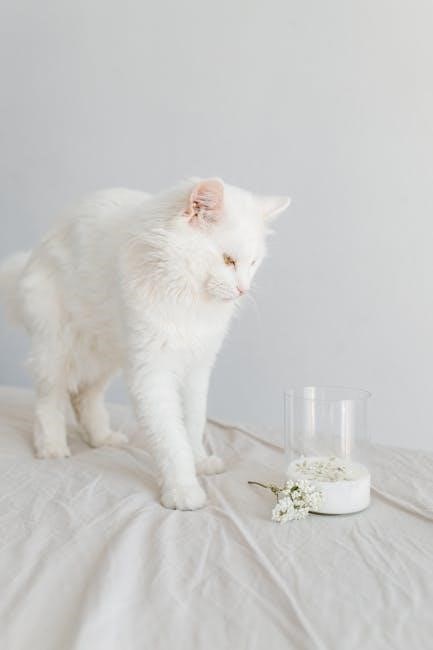
During this phase, it’s crucial to introduce variety in their diet while maintaining KMR as a supplement. Avoid overfeeding, as kittens can easily gain excess weight. Always use clean equipment and store prepared KMR properly to prevent spoilage. Transitioning smoothly during this period sets the foundation for a healthy, balanced diet in adulthood.

Monitoring a Kitten’s Health
Regularly monitor your kitten’s weight, hydration, and overall energy levels. Ensure proper digestion by checking for firm, brown stools and avoiding diarrhea or constipation. Watch for active behavior and a shiny coat, as these indicate healthy feeding and development.
Signs of Healthy Feeding
Monitoring your kitten’s health is crucial to ensure proper development. Signs of healthy feeding include steady weight gain, active behavior, and a shiny, clean coat. A well-fed kitten should have bright eyes, firm stools, and good hydration levels. Look for energetic play, proper latching during feeding, and contentment afterward. Avoid overfeeding or underfeeding by tracking feeding schedules and portion sizes. Healthy kittens typically gain 10-15 grams daily. If your kitten shows lethargy, diarrhea, or refusal to eat, consult a vet immediately. Proper digestion and absorption of KMR are vital for growth, so always ensure the formula is mixed correctly. Regular weigh-ins and observing overall vitality will help confirm your kitten is thriving. A happy, active kitten is the best indicator of successful feeding.
Recognizing Feeding-Related Health Issues
Identifying feeding-related health issues in kittens is crucial for their well-being. Common signs include diarrhea, dehydration, vomiting, or lethargy after feeding. If a kitten refuses to eat, shows lack of interest in feeding, or exhibits persistent crying, it may indicate discomfort or illness. Overfeeding can lead to bloating, while underfeeding may cause excessive hunger or weight loss. Watch for loose stools, which can signal improper digestion or bacterial imbalances. Dehydration is a serious concern, as kittens rely on proper hydration for survival. If your kitten’s skin tents when pinched or their gums feel dry, seek veterinary care immediately. Vomiting after feeding could indicate an intolerance to the formula or an infection. Always monitor your kitten’s behavior and physical condition after feeding to ensure they are thriving. If any of these symptoms persist, consult a vet to address potential health issues early and prevent complications.
Troubleshooting Common Feeding Issues
Identify feeding issues early, such as refusal to eat or digestive problems. Check for proper KMR preparation and feeding technique. Adjust as needed and consult a vet if issues persist.
Addressing Litter Box Problems
Litter box issues in kittens can stem from feeding challenges, such as diarrhea caused by improper KMR preparation or overfeeding. Ensure the KMR is mixed correctly, using one part powder to two parts warm water. If diarrhea persists, consult a veterinarian to rule out underlying health issues. Kittens may also avoid the litter box if it is too large or uncomfortable. Provide a shallow, clean litter box and place the kitten in it after feeding to encourage proper habits. If the kitten refuses to use the litter box, gentle guidance and consistency are key. Monitor the kitten’s behavior and adjust feeding schedules if necessary. A well-fed, healthy kitten is more likely to use the litter box correctly. Always keep the litter area clean to promote good hygiene and training success.

What to Do if a Kitten Won’t Eat
If a kitten refuses to eat, it can be a sign of stress, illness, or discomfort. Gently stimulate the kitten’s appetite by offering small amounts of warm KMR formula. Use a syringe or bottle to slowly introduce the milk replacer, allowing the kitten to suckle naturally. If the kitten still refuses, check the formula’s temperature; it should be slightly warm, not hot. Sometimes, kittens may need encouragement, such as gentle stroking or rubbing their cheeks. If the kitten continues to resist feeding, consult a veterinarian to rule out underlying health issues. Prolonged refusal to eat can lead to dehydration and weight loss, which are critical conditions in young kittens. Always ensure the KMR is fresh and properly mixed, as spoiled or incorrect ratios can deter the kitten from feeding. Persistence and patience are key, but professional guidance is essential if the issue persists.
Proper KMR feeding is crucial for kittens’ growth and health. Always follow mixing instructions, monitor feeding schedules, and seek veterinary advice if issues arise. Consistency and care ensure a thriving kitten with a strong foundation for life.
Final Tips for Successful KMR Feeding
For successful KMR feeding, always prepare fresh formula using the correct ratio of one part powder to two parts warm water. Avoid using cow’s milk, as it can cause digestive issues. Feed kittens every 3-4 hours, adjusting portions based on age and weight. Burp gently after each feeding to prevent discomfort. Store prepared KMR in the refrigerator for up to 24 hours and discard any unused portions. Monitor your kitten’s weight, behavior, and stool quality to ensure proper nutrition. If your kitten refuses to eat or shows signs of illness, consult a veterinarian promptly. Keep feeding times calm and stress-free to encourage healthy eating habits. By following these tips, you can help your kitten thrive during this critical growth phase. Remember, consistency and attention to detail are key to successful KMR feeding and your kitten’s overall health. Always prioritize your kitten’s well-being and seek professional advice if needed.
